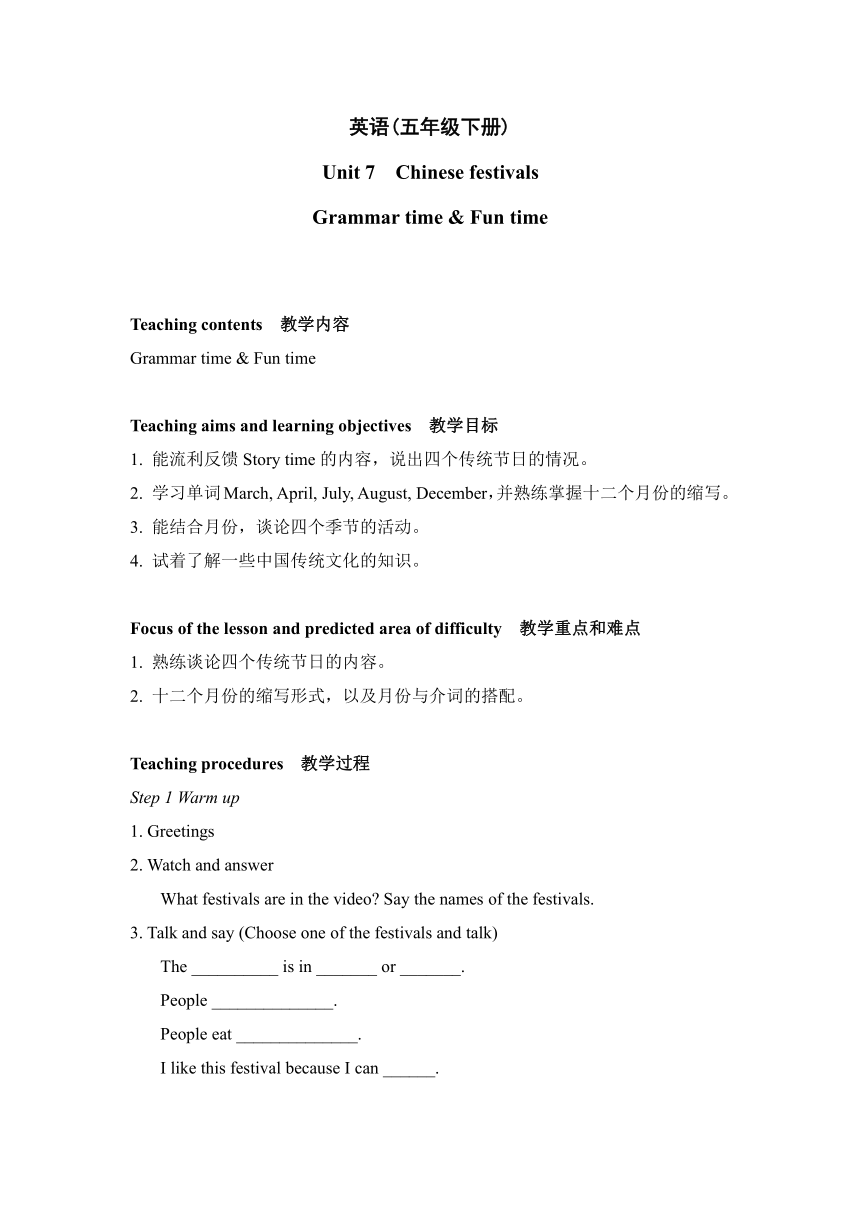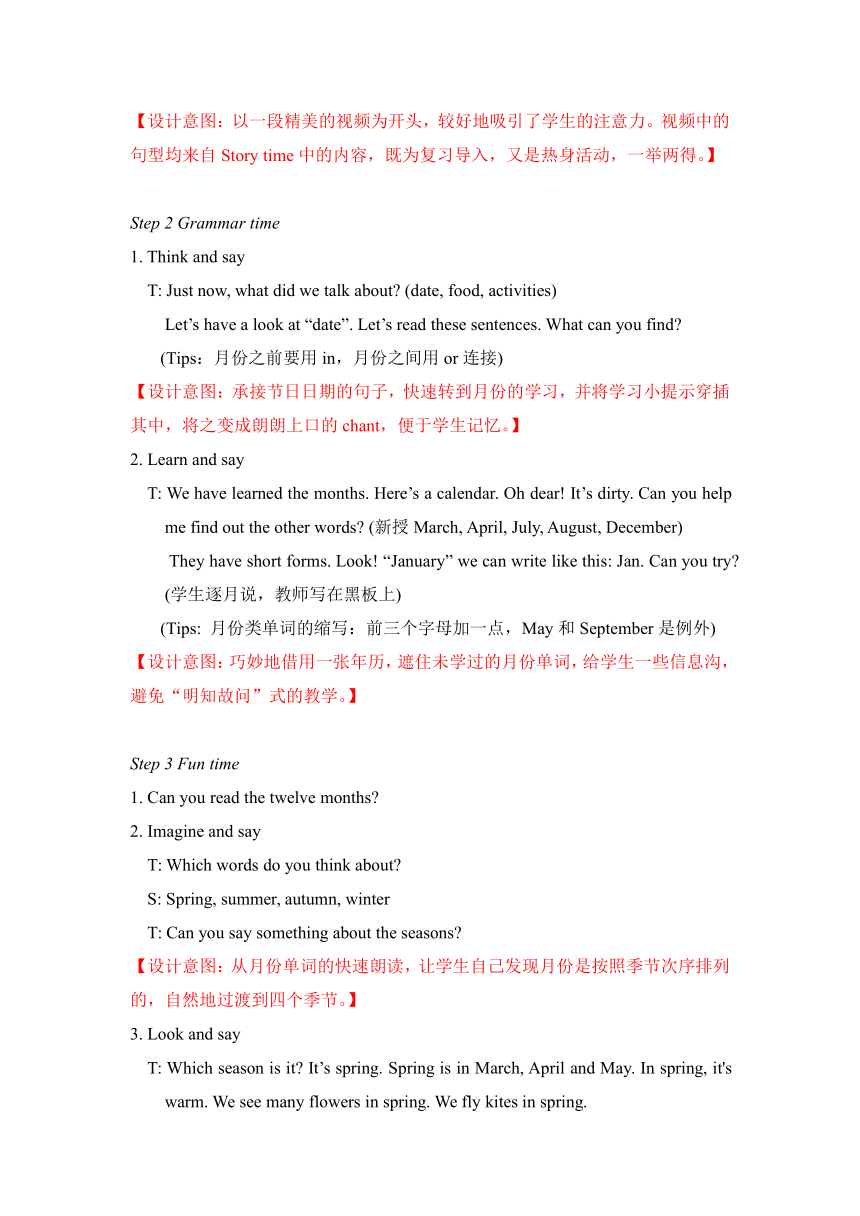Unit7 Chinese festivals Fun time 教案(含反思)
文档属性
| 名称 | Unit7 Chinese festivals Fun time 教案(含反思) |

|
|
| 格式 | zip | ||
| 文件大小 | 4.6MB | ||
| 资源类型 | 教案 | ||
| 版本资源 | 牛津译林版 | ||
| 科目 | 英语 | ||
| 更新时间 | 2020-02-08 08:56:02 | ||
图片预览


文档简介
英语(五年级下册)
Unit 7 Chinese festivals
Grammar time & Fun time
Teaching contents 教学内容
Grammar time & Fun time
Teaching aims and learning objectives 教学目标
1. 能流利反馈Story time的内容,说出四个传统节日的情况。
2. 学习单词March, April, July, August, December,并熟练掌握十二个月份的缩写。
3. 能结合月份,谈论四个季节的活动。
4. 试着了解一些中国传统文化的知识。
Focus of the lesson and predicted area of difficulty 教学重点和难点
1. 熟练谈论四个传统节日的内容。
2. 十二个月份的缩写形式,以及月份与介词的搭配。
Teaching procedures 教学过程
Step 1 Warm up
1. Greetings
2. Watch and answer
What festivals are in the video? Say the names of the festivals.
3. Talk and say (Choose one of the festivals and talk)
The __________ is in _______ or _______.
People ______________.
People eat ______________.
I like this festival because I can ______.
【设计意图:以一段精美的视频为开头,较好地吸引了学生的注意力。视频中的句型均来自Story time中的内容,既为复习导入,又是热身活动,一举两得。】
Step 2 Grammar time
1. Think and say
T: Just now, what did we talk about? (date, food, activities)
Let’s have a look at “date”. Let’s read these sentences. What can you find?
(Tips:月份之前要用in,月份之间用or连接)
【设计意图:承接节日日期的句子,快速转到月份的学习,并将学习小提示穿插其中,将之变成朗朗上口的chant,便于学生记忆。】
2. Learn and say
T: We have learned the months. Here’s a calendar. Oh dear! It’s dirty. Can you help me find out the other words? (新授March, April, July, August, December)
They have short forms. Look! “January” we can write like this: Jan. Can you try? (学生逐月说,教师写在黑板上)
(Tips: 月份类单词的缩写:前三个字母加一点,May和September是例外)
【设计意图:巧妙地借用一张年历,遮住未学过的月份单词,给学生一些信息沟,避免“明知故问”式的教学。】
Step 3 Fun time
1. Can you read the twelve months?
2. Imagine and say
T: Which words do you think about?
S: Spring, summer, autumn, winter
T: Can you say something about the seasons?
【设计意图:从月份单词的快速朗读,让学生自己发现月份是按照季节次序排列的,自然地过渡到四个季节。】
3. Look and say
T: Which season is it? It’s spring. Spring is in March, April and May. In spring, it's warm. We see many flowers in spring. We fly kites in spring.
T: Practice in pairs, talk about the four seasons and use sentences as more as you can.
T: OK! Here is a big wheel. I will spin it. Then it will stop. (转动大转盘,停在哪个季节,就谈论哪个季节)
4. Draw and say
T: After class, you many draw the four seasons and talk about them.
【设计意图:季节的内容是以前早学过的,学生比较熟悉,让他们发散思维,说一说相关的活动,既是复习,也是为谈论季节做准备。】
Step 4 Chinese traditional culture
1. Enjoy and share
T: They’re seasons too. They’re nice bookmarks. I’ll show you more.
2. Enjoy and write
T: Find the bookmark, write about festivals or seasons on it, and then send it to your friend. Who can show your bookmark?
3. T: They’re all about Chinese traditional culture. To be a Chinese, we should “Inherit Chinese culture, Transmit our tradition.”
【设计意图:精美的中国风书签较好地吸引了学生的眼球,也为引出中国传统文化的话题做了铺垫,并号召学生以自己的英语能力,尽可能地传播中国文化。】
Homework 家庭作业
1. Talk about Chinese festivals and seasons.
2. Send the bookmark to your friend or family.
3. Know more about Chinese traditional culture.
Teaching aids 教学准备(含板书设计)
教学准备:词汇卡、多媒体PPT
板书设计:
说课
这是一节颇具中国味道的课,PPT的制作、背景、图片、音乐和视频的选取都具有浓浓的中国传统气息,是当下流行的中国风主题。
1. 各个环节过渡自然,巧妙衔接,从复习Story time的内容入手,谈论节日的日期,引出十二个月份及其缩略形式。快读朗读各个月份的单词,按照春夏秋冬四季的规律排列,先让学生发散思维,自己说出季节名称,再过渡到季节的相关活动,由简入深,从短语到句子和语篇,较好地训练了说的能力。最后以四个季节的书签导入,先展示一组精美的中国风书签,然后让学生写一写自己喜欢的节日或季节,则很好地将读的能力转化成写的能力。
2. 将语法点编成朗朗上口的chant,帮助学生记忆,避免语法教学的枯燥性。
3. 全面关注全体学生,很多练习的设计充分考虑到学生的“学”,人人参与,整个课堂无死角。
4. 充分渗透中国的文化。利用一段视频向学生展示了博大精深的中国传统文化,激发起学生的爱国情绪,并立志要用自己的英语能力向世界介绍中国文化。不足之处是整节课的节奏稍显拖沓,不够明快。内容还不够充实。
Unit 7 Chinese festivals
Grammar time & Fun time
Teaching contents 教学内容
Grammar time & Fun time
Teaching aims and learning objectives 教学目标
1. 能流利反馈Story time的内容,说出四个传统节日的情况。
2. 学习单词March, April, July, August, December,并熟练掌握十二个月份的缩写。
3. 能结合月份,谈论四个季节的活动。
4. 试着了解一些中国传统文化的知识。
Focus of the lesson and predicted area of difficulty 教学重点和难点
1. 熟练谈论四个传统节日的内容。
2. 十二个月份的缩写形式,以及月份与介词的搭配。
Teaching procedures 教学过程
Step 1 Warm up
1. Greetings
2. Watch and answer
What festivals are in the video? Say the names of the festivals.
3. Talk and say (Choose one of the festivals and talk)
The __________ is in _______ or _______.
People ______________.
People eat ______________.
I like this festival because I can ______.
【设计意图:以一段精美的视频为开头,较好地吸引了学生的注意力。视频中的句型均来自Story time中的内容,既为复习导入,又是热身活动,一举两得。】
Step 2 Grammar time
1. Think and say
T: Just now, what did we talk about? (date, food, activities)
Let’s have a look at “date”. Let’s read these sentences. What can you find?
(Tips:月份之前要用in,月份之间用or连接)
【设计意图:承接节日日期的句子,快速转到月份的学习,并将学习小提示穿插其中,将之变成朗朗上口的chant,便于学生记忆。】
2. Learn and say
T: We have learned the months. Here’s a calendar. Oh dear! It’s dirty. Can you help me find out the other words? (新授March, April, July, August, December)
They have short forms. Look! “January” we can write like this: Jan. Can you try? (学生逐月说,教师写在黑板上)
(Tips: 月份类单词的缩写:前三个字母加一点,May和September是例外)
【设计意图:巧妙地借用一张年历,遮住未学过的月份单词,给学生一些信息沟,避免“明知故问”式的教学。】
Step 3 Fun time
1. Can you read the twelve months?
2. Imagine and say
T: Which words do you think about?
S: Spring, summer, autumn, winter
T: Can you say something about the seasons?
【设计意图:从月份单词的快速朗读,让学生自己发现月份是按照季节次序排列的,自然地过渡到四个季节。】
3. Look and say
T: Which season is it? It’s spring. Spring is in March, April and May. In spring, it's warm. We see many flowers in spring. We fly kites in spring.
T: Practice in pairs, talk about the four seasons and use sentences as more as you can.
T: OK! Here is a big wheel. I will spin it. Then it will stop. (转动大转盘,停在哪个季节,就谈论哪个季节)
4. Draw and say
T: After class, you many draw the four seasons and talk about them.
【设计意图:季节的内容是以前早学过的,学生比较熟悉,让他们发散思维,说一说相关的活动,既是复习,也是为谈论季节做准备。】
Step 4 Chinese traditional culture
1. Enjoy and share
T: They’re seasons too. They’re nice bookmarks. I’ll show you more.
2. Enjoy and write
T: Find the bookmark, write about festivals or seasons on it, and then send it to your friend. Who can show your bookmark?
3. T: They’re all about Chinese traditional culture. To be a Chinese, we should “Inherit Chinese culture, Transmit our tradition.”
【设计意图:精美的中国风书签较好地吸引了学生的眼球,也为引出中国传统文化的话题做了铺垫,并号召学生以自己的英语能力,尽可能地传播中国文化。】
Homework 家庭作业
1. Talk about Chinese festivals and seasons.
2. Send the bookmark to your friend or family.
3. Know more about Chinese traditional culture.
Teaching aids 教学准备(含板书设计)
教学准备:词汇卡、多媒体PPT
板书设计:
说课
这是一节颇具中国味道的课,PPT的制作、背景、图片、音乐和视频的选取都具有浓浓的中国传统气息,是当下流行的中国风主题。
1. 各个环节过渡自然,巧妙衔接,从复习Story time的内容入手,谈论节日的日期,引出十二个月份及其缩略形式。快读朗读各个月份的单词,按照春夏秋冬四季的规律排列,先让学生发散思维,自己说出季节名称,再过渡到季节的相关活动,由简入深,从短语到句子和语篇,较好地训练了说的能力。最后以四个季节的书签导入,先展示一组精美的中国风书签,然后让学生写一写自己喜欢的节日或季节,则很好地将读的能力转化成写的能力。
2. 将语法点编成朗朗上口的chant,帮助学生记忆,避免语法教学的枯燥性。
3. 全面关注全体学生,很多练习的设计充分考虑到学生的“学”,人人参与,整个课堂无死角。
4. 充分渗透中国的文化。利用一段视频向学生展示了博大精深的中国传统文化,激发起学生的爱国情绪,并立志要用自己的英语能力向世界介绍中国文化。不足之处是整节课的节奏稍显拖沓,不够明快。内容还不够充实。
